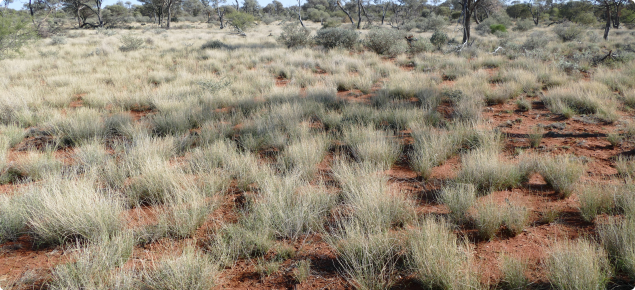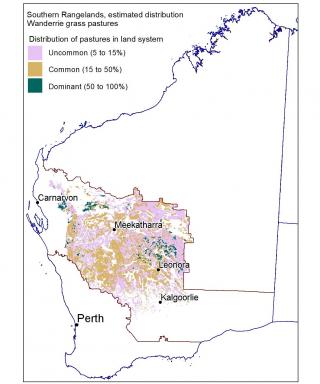Pastoral potential – moderate
Wanderrie grass pastures typically have moderate pastoral value. The density of palatable species varies depending upon fire and grazing history. They are capable of carrying stock on a year-long basis with adequate waters and conservative stocking rates.
Suggested levels of use (per annum)
Table 1 provides a rough guide to the range of pastoral values for good condition pastures, which must be checked against conditions in each region and paddock. Carrying capacities for fair condition pastures might be 75% to 50% of good, and poor condition pastures less than 50% of good.
See Introduction to pastures in the southern rangelands of Western Australia for an explanation of how carrying capacities are estimated.
| Condition | Carrying capacity ha/DSE1 | Carrying capacity ha/CU2 (ha/AE3) |
|---|---|---|
| Good | 15–19.9 | 105–139 (126–167) |
1 DSE is based on the feed energy required to maintain a 45 kilogram liveweight Merino wether with zero weight change, no wool growth additional to that included in maintenance, and walking 7 km/day. 1 DSE has an energy requirement of approximately 8.7 MJ ME/day.
2 CU in the southern rangelands is based on a 400 kg steer at maintenance and equivalent to 7 DSE.
3 AE is based on the feed energy to maintain a 450 kg Bos taurus steer 2.25 years of age, walking 7 kilometers each day. 1 AE has an energy requirement of approximately 73 MJ ME/day and equivalent to 8.4 DSE.
Managing Wanderrie grass pastures in the southern rangelands
These pastures generally have low to moderate value as a reserve in poor seasons, due to the low density of palatable low shrubs and the relatively short-lived nature of the wanderrie grasses. Stocking rates should be adjusted when annual feed is declining so that perennial plants are not overgrazed. Recovery of wanderrie grasses is much slower than buffel and birdwood grasses following grazing.
Fires in wanderrie grass pastures are patchier than in sandplain pastures. On burnt areas, common low shrubs include cotton bush, flannel bush, tall saltbush, Wilcox bush, cottony saltbush, flat leaf bluebush, ruby saltbush, warty-leaf eremophila, horse mulla mulla, crinkle leaf cassia, fire bush and native poplar. Taller shrubs may include limestone wattle in later stages.
Where perennial grasses are depleted, but palatable shrubs remain, rehabilitation of the pasture can be achieved by resting pastures for six to twelve months after effective summer rains repeatedly until grasses are re-established and recruiting (Wilcox 1960). Longer periods of rest (dependent on seasonal conditions: drier=longer) will be required where desirable shrubs are depleted, to allow re-established and recruiting. Providing rest for these pastures is recommended following prolonged dry periods.
Pasture condition
Survey data show that wanderrie grass pastures in the southern rangelands are predominantly in poor condition, except where a lack of stock water has prevented grazing. Most wanderrie grass pastures have deteriorated to the extent that the perennial grasses have disappeared and have been replaced by windgrass, three-awn wanderrie and annual forbs. Valuable shrub species such as Wilcox bush and tall saltbush have also disappeared with overuse. Cattle appear to affect the shrub component less than sheep; overgrazing by sheep causes the loss of both the palatable perennial grasses and the desirable shrubs.
Good
See Figure 1. Palatable low shrubs such as warty-leaf eremophila, Wilcox bush and tall saltbush are scattered throughout the pasture. Cotton bush and flannel bush are occasionally present at low densities and wanderrie grasses form a sparse to dense ground layer. There is no erosion.
Fair
See Figure 2. A small proportion of palatable low shrubs remains and favoured plants may show poor vigour. Undesirable species are uncommon and generally do not increase, however, the less palatable buck wanderrie grass may increase. Erosion is uncommon.
Poor
See Figure 3. There are no palatable low shrubs. Annual grasses such as wind grass and three-awn wanderrie and forbs become dominant in poor condition. Erosion is limited to rilling and gullying on the more concentrated flow lines, with sheeting occurring along the edges of the sandbanks near lines of concentrated flow.
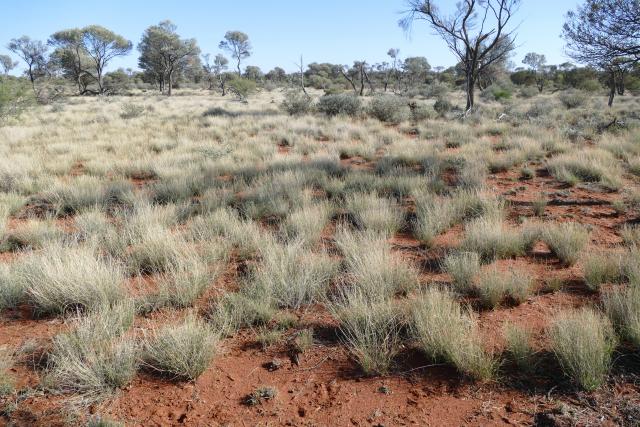
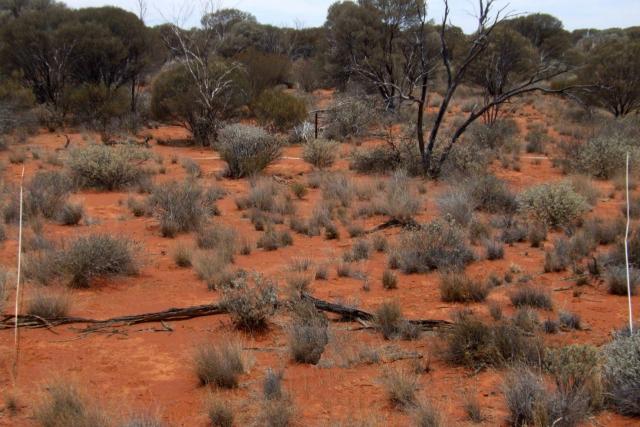
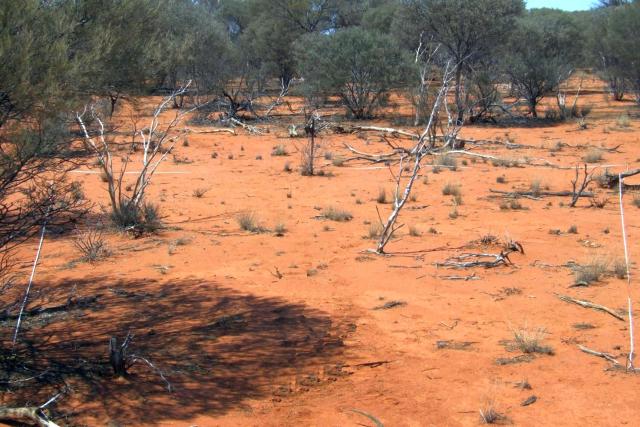
Vegetation structure and composition
Wanderrie grass pastures generally have scattered projected foliar cover (10–25%), with the grass component of 5–10% cover. Important perennial grasses include palatable broad leaf wanderrie, soft wanderrie and woollybutt grass and the less palatable buck wanderrie grass. Grass density is variable depending on landform, season and grazing pressure.
Wanderrie grass pastures are similar to sandplain acacia pastures and share many equivalent species. Sandplain acacia pastures occur on deep sands, whereas wanderrie grass pastures are generally on sand sheets over hardpan. There is a sparse to dense cover of mulga, witchetty bush and bowgada on the banks and interbanks. Dense stands of low shrubs may be present post-fire or after the acacias senesce.
Annual grasses such as wind grass and three-awn wanderrie grass and forbs occupy inter-tussock spaces in season.
Occurrence
Wanderrie grass pastures occur in the Gascoyne, Murchison and Goldfields, covering about 4.92 million hectares (6.1% of the southern rangelands) (Figure 4). These pastures occur on sandy banks and sand sheets, generally overlying hardpan. They occur on ironstone gravel plains on deep red earths less frequently. Wanderrie banks can be in organised patterns (linear and parallel), or less organised and irregularly shaped as on the gravel plains. The largest areas are in Bullimore, Monk, Yowie, Kalli, Yanganoo, Desdemona and Belele land systems.
Associated plants
| Common name | Scientific name | Desirability* |
|---|---|---|
| Broad leaf wanderrie grass | D | |
| Cotton bush | D | |
| Currant bush | D | |
| Flat leaf bluebush | D | |
| Golden bluebush, George's bluebush | D | |
| Green cassia | D | |
| Horse mulla mulla | D | |
| Mulga bluebush | D | |
| Native currant | D | |
| Ruby saltbush | D | |
| Silky bluebush | D | |
| Soft wanderrie grass | D | |
| Tall saltbush | D | |
| Tall sida | D | |
| Warty-leaf eremophila | D | |
| Wilcox bush | D | |
| Woollybutt grass | D | |
| Crinkle leaf cassia | U | |
| Needlebush | U | |
| Sandbank poverty bush | U | |
| Tomato bush | U | |
| Bowgada, wanyu, horse mulga | I | |
| Buck wanderrie grass | I | |
| Curara | I | |
| Gidgee, yalardy | I | |
| Flannel bush | I | |
| Limestone wattle | I | |
| Mulga | I | |
| Mulga broombush | I | |
| Cottony saltbush | I | |
| Showy poverty bush | I | |
| Spreading gidgee | I | |
| Thin-leaved poverty bush | I | |
| Turpentine bush | I | |
| Witchetty bush, granite wattle | I | |
| Creeping wanderrie grass | N | |
| Shark Bay poverty bush | N | |
| Native poplar | N | |
| Firebush | N | |
| Three-awned wanderrie grass | annual | |
| Wind grass | annual |
1 North-east only; 2 West only
* D = desirable, U = undesirable, I = intermediate, N = no indicator value
Other resources
- Wilcox, DG (1960) ‘The grazing of Wanderrie grass associations,’ Journal of the Department of Agriculture, Western Australia, series 4: vol. 1: no. 6, article 4.

